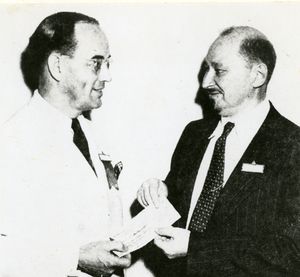S. A. Schelkunoff: Difference between revisions
No edit summary |
|||
| (4 intermediate revisions by 2 users not shown) | |||
| Line 1: | Line 1: | ||
== | {{Biography | ||
|Image=Schelkunoff and Van Dyck.jpg | |||
|Caption=Dr. Schelkunoff (right) receiving from President Van Dyck the check for the Morris Liebmann Memorial Prize for 1942 | |||
|Birthdate=1897/01/27 | |||
|Birthplace=Samara, Russia | |||
|Death date=1992/05/02 | |||
|Associated organizations=[[Bell Labs]] | |||
|Fields of study=[[Radar]]; [[Radio]] | |||
|Awards=Morris N. Liebmann Memorial Award; Stuart Ballantine | |||
}} | |||
Dr. Sergei Alexander Schelkunoff was a mathematician and electromagnetism theorist. He is known for his contributions to antenna theory. | Dr. Sergei Alexander Schelkunoff was a mathematician and electromagnetism theorist. He is known for his contributions to antenna theory. | ||
Schelkunoff was was born on January 27, 1897 in Samara, Russia. He began his studies at the University of Moscow but was drafted in 1917. By 1921 he settled in Seattle where he received his bachelor's and master's degrees in mathematics from the State College of Washington (now the University of Washington). Schelkunoff received his doctoral degree in 1928 from Columbia University. | Schelkunoff was was born on January 27, 1897 in Samara, Russia. He began his studies at the University of Moscow but was drafted in 1917. By 1921 he settled in Seattle where he received his bachelor's and master's degrees in mathematics from the State College of Washington (now the University of Washington). Schelkunoff received his doctoral degree in 1928 from Columbia University. | ||
Schelkunoff joined Western Electric, which eventually became Bell Labs, after earning his PhD. He worked in the company's research department. In 1935, Schelkunoff and three of his colleagues discovered that the coaxial cable, which was new at the time, had the ability to transmit television and up to 200 telephone circuits. The coaxial cable is now widely used in television transmission. | Schelkunoff joined Western Electric, which eventually became [[Bell Labs]], after earning his PhD. He worked in the company's research department. In 1935, Schelkunoff and three of his colleagues discovered that the coaxial cable, which was new at the time, had the ability to transmit television and up to 200 telephone circuits. The coaxial cable is now widely used in television transmission. | ||
Schelkunoff's career at Bell Labs lasted for a total of 35 years, and during that time his research encompassed [[Radar|radar]], short-wave radio, broad-band antennas, electromagnetic wave propagation in the atmosphere and in microwave guides, and grounding. In addition to his work at Bell Labs, he also taught for 5 years at Columbia University and held the position of assistant director of mathematical research and assistant vice president for university relations. Schelkunoff retired from Columbia in 1965 and was a consultant for the United States Naval Station in San Diego. | |||
Schelkunoff authored 4 books and several technical articles, and held 15 patents. He received the 1942 [[IEEE Morris N. Liebmann Memorial Award|Morris N. Liebmann Memorial Award]] from the IRE and the 1949 Stuart Ballantine Medal from the Franklin Institute. He died in Hightstown, New Jersey on May 2, 1992. | |||
Schelkunoff | {{DEFAULTSORT:Schelkunoff}} | ||
[[Category:Environment]] | |||
[[Category:Radar]] | |||
Latest revision as of 15:18, 19 February 2019
Biography
Dr. Sergei Alexander Schelkunoff was a mathematician and electromagnetism theorist. He is known for his contributions to antenna theory.
Schelkunoff was was born on January 27, 1897 in Samara, Russia. He began his studies at the University of Moscow but was drafted in 1917. By 1921 he settled in Seattle where he received his bachelor's and master's degrees in mathematics from the State College of Washington (now the University of Washington). Schelkunoff received his doctoral degree in 1928 from Columbia University.
Schelkunoff joined Western Electric, which eventually became Bell Labs, after earning his PhD. He worked in the company's research department. In 1935, Schelkunoff and three of his colleagues discovered that the coaxial cable, which was new at the time, had the ability to transmit television and up to 200 telephone circuits. The coaxial cable is now widely used in television transmission.
Schelkunoff's career at Bell Labs lasted for a total of 35 years, and during that time his research encompassed radar, short-wave radio, broad-band antennas, electromagnetic wave propagation in the atmosphere and in microwave guides, and grounding. In addition to his work at Bell Labs, he also taught for 5 years at Columbia University and held the position of assistant director of mathematical research and assistant vice president for university relations. Schelkunoff retired from Columbia in 1965 and was a consultant for the United States Naval Station in San Diego.
Schelkunoff authored 4 books and several technical articles, and held 15 patents. He received the 1942 Morris N. Liebmann Memorial Award from the IRE and the 1949 Stuart Ballantine Medal from the Franklin Institute. He died in Hightstown, New Jersey on May 2, 1992.
